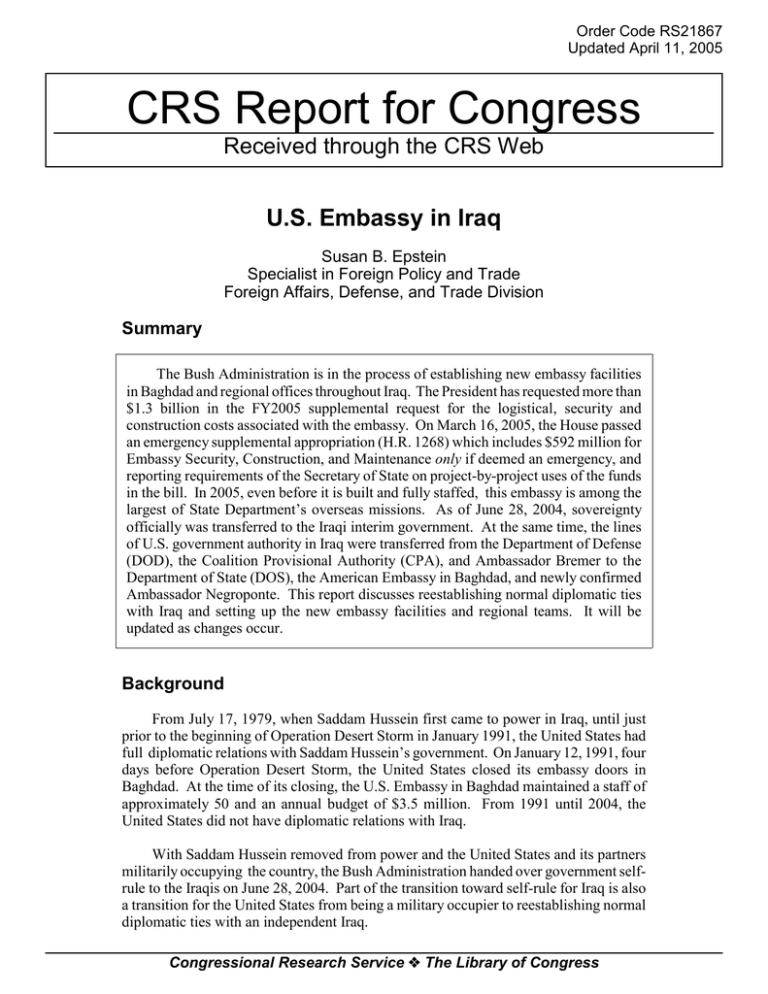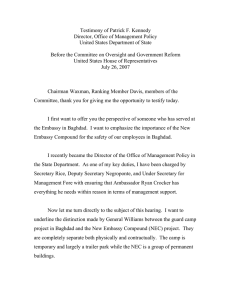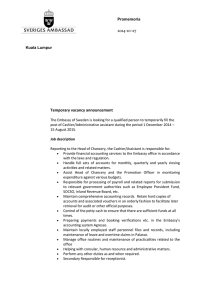CRS Report for Congress U.S. Embassy in Iraq Summary
advertisement

Order Code RS21867 Updated April 11, 2005 CRS Report for Congress Received through the CRS Web U.S. Embassy in Iraq Susan B. Epstein Specialist in Foreign Policy and Trade Foreign Affairs, Defense, and Trade Division Summary The Bush Administration is in the process of establishing new embassy facilities in Baghdad and regional offices throughout Iraq. The President has requested more than $1.3 billion in the FY2005 supplemental request for the logistical, security and construction costs associated with the embassy. On March 16, 2005, the House passed an emergency supplemental appropriation (H.R. 1268) which includes $592 million for Embassy Security, Construction, and Maintenance only if deemed an emergency, and reporting requirements of the Secretary of State on project-by-project uses of the funds in the bill. In 2005, even before it is built and fully staffed, this embassy is among the largest of State Department’s overseas missions. As of June 28, 2004, sovereignty officially was transferred to the Iraqi interim government. At the same time, the lines of U.S. government authority in Iraq were transferred from the Department of Defense (DOD), the Coalition Provisional Authority (CPA), and Ambassador Bremer to the Department of State (DOS), the American Embassy in Baghdad, and newly confirmed Ambassador Negroponte. This report discusses reestablishing normal diplomatic ties with Iraq and setting up the new embassy facilities and regional teams. It will be updated as changes occur. Background From July 17, 1979, when Saddam Hussein first came to power in Iraq, until just prior to the beginning of Operation Desert Storm in January 1991, the United States had full diplomatic relations with Saddam Hussein’s government. On January 12, 1991, four days before Operation Desert Storm, the United States closed its embassy doors in Baghdad. At the time of its closing, the U.S. Embassy in Baghdad maintained a staff of approximately 50 and an annual budget of $3.5 million. From 1991 until 2004, the United States did not have diplomatic relations with Iraq. With Saddam Hussein removed from power and the United States and its partners militarily occupying the country, the Bush Administration handed over government selfrule to the Iraqis on June 28, 2004. Part of the transition toward self-rule for Iraq is also a transition for the United States from being a military occupier to reestablishing normal diplomatic ties with an independent Iraq. Congressional Research Service ˜ The Library of Congress CRS-2 Organizational Structure The U.S. Ambassador to Iraq has full authority for the American presence in Iraq with two exceptions: 1 — military and security matters which are under the authority of General George Casey, the U.S. Commander of the Multinational Force-Iraq (MNF-I), and 2 — staff working for international organizations. In areas where diplomacy, military, and/or security activities overlap, the Ambassador and the U.S. commander continue cooperating to provide co-equal authority regarding what’s best for America and its interests in Iraq. The U.S. Embassy in Baghdad is among the largest American embassies in both staff size and budget. According to the State Department, the U.S. Mission in Baghdad is staffed with about 1,000 Americans representing various U.S. government agencies and between 300 and 400 locally engaged staff (LES, formerly referred to as foreign service nationals, or FSN). Americans representing about 11 government agencies are providing the face of America in the embassy and regional offices in Iraq. The agencies include the Departments of State (DOS), Defense (DOD), Agriculture (USDA), Commerce (DoC), Homeland Security (DHS), Health and Human Services (HHS), Justice (DoJ), Labor (DoL), Transportation (DoT), Treasury, and the Agency for International Development (USAID). Agencies that did not recommend staff for an Iraq presence include Departments of Energy, the Interior, and Veterans Affairs, as well as NASA, Peace Corps, Secret Service, and Social Security. The United States has a number of experts from the various agencies on the ground in Iraq working as teams to determine such needs as security, skills, expenditures, contracting and logistics, communications/ information technology, and real estate. In addition, the United States has consultants from the agencies working in an ongoing basis with the various Iraqi ministries such as the Iraqi Health Ministry, Education Ministry, Foreign Ministry, Ministry of Oil, etc. to help Iraq gain a strong foothold on democracy and administrative skills. (See the organizational chart, Figure 1, on page 5.) Location, Security, and the Role of U.S. Diplomatic Posts in Iraq The State Department is using three sites for embassy-related needs. The sites are the Chancery, formerly a Baathist residence which was later occupied by the U.S. Army; the Annex (the Republican Palace) previously used by the CPA; and the Ambassador’s residence, once occupied by Ambassadors Bremer and Negoponte. The U.S. government is not paying Iraq for the use of property and buildings, according to the State Department. The Iraqi government has reportedly requested that these facilities be returned to it. On October 31, 2004, the United States and Iraqi Ministry of Foreign Affairs signed an agreement on diplomatic and consular property. Among other things, this agreement transferred to the United States title to a site for the new American Embassy compound and future consulate sites in Basra and Mosul. State’s Overseas Buildings Operations (OBO) identified property for a New Embassy Compound (NEC) on a site adjacent to the Tigris River in the Green Zone. OBO has estimated that NEC can be constructed within CRS-3 two years of receiving appropriations from Congress. All consular affairs activities, trade promotion, and other diplomatic roles will be conducted from Baghdad. Regional teams are located in Mosul, Kirkuk, Basrah, and Hillah; each consists of limited staff representing DOS, as well as other agencies and contractors in designated locations. Altogether, 46 people are spread among the regional offices. (See the map, Figure 2, on page 6.) Each regional team’s mission is primarily advising and coordinating with local officials and interacting with citizens to better understand the attitudes of the Iraqi people toward America. Both in Baghdad and in the regional offices, American Foreign Service Officers will be conducting public diplomacy — promoting American values and policies in Iraq. Beyond the official consulate posts in Iraq, the Department of State has Foreign Service Officers embedded in major U.S. military commands located outside of Baghdad. DOS and DOD civilian employees also are at these locations. The State Department reportedly plans on having a total of 50 personnel in the Iraq provinces, including diplomatic security personnel. Security is key to establishing diplomatic relations. The current facilities used by DOS in Baghdad have been subject to attacks, some of which have injured and killed Americans. According to the Department of State, Diplomatic Security (DS) has responsibility for embassy security. Overall security in the country, however, will continue to be the responsibility of the commander of the multinational forces. DOD and contractors will continue to be major contributors to a secure atmosphere. Regarding funding of security activities, the Administration has determined that security for the embassy will come from a combination of DOD’s budget, as well as State’s Diplomatic Security funds. Funding According to the State Department, preliminary funding estimates for construction of the new embassy compound in Iraq were $1.2 billion, not including refurbishing and securing interim buildings. To date, Congress has authorized $20 million for activities related to building a new embassy in Baghdad (P.L. 108-287). In his FY2006 budget request, President Bush did not include funds for construction of the U.S. Mission in Iraq.1 A week after submitting his FY2006 budget to Congress, the President sent Congress an FY2005 emergency supplemental funding request. Included in the supplemental is more than $1.3 billion for the embassy in Iraq: $690 million for logistical and security costs for the embassy in Baghdad and $658 million for construction of the new embassy compound there. Included in the latter are the costs of housing, a power plant, enhanced security, and expedited (24-month) construction. The State Department has been provided $990.85 million thus far for security, logistics, and operation expenses of the U.S. Mission in Iraq: the FY2003 and FY2004 supplementals provided $35.8 million from State’s Diplomatic and Consular Program (D&CP) account for initial security and startup. Another $105.75 million came from the 4th quarter FY2004 Coalition Provisional Authority (CPA) appropriations. About 1% of 1 The FY2006 budget request did include $65 million for Iraq embassy functions. CRS-4 the $18.4 billion (or $184 million) of the Iraq Relief and Reconstruction Funds (IRRF) has been designated for Mission operations in FY2005. Also, DOD’s FY2005 appropriations (H.R. 4613/P.L. 108-287) included an amendment for $665.3 million for State Department’s D&CP for costs in Iraq. Congressional Responsibilities While conducting foreign policy is the prerogative of the President, Congress maintains three important responsibilities with respect to U.S. foreign policy: 1) confirmation of political appointees (held by the Senate), 2) appropriations, and 3) oversight. Congressional opportunities to have input on U.S. diplomatic relations with Iraq and the embassy can occur within the nomination confirmation process, the annual State Department appropriation legislation, and biennial foreign relations authorization. The position of Ambassador to Iraq was initially filled by John Negroponte, who served from May 2004 to March 2005. On April 5, Secretary Rice announced President Bush’s intention to nominate Zalmay Khalilzad (formerly the Ambassador to Afghanistan) as the new U.S. Ambassador to Iraq;2 this appointment requires Senate confirmation. Appropriations for the new U.S. Mission in Iraq have come from a variety of sources. To date, no funds for either the interim buildings or new embassy construction have come from the regular appropriations process, according to the Department of State. The initial phase of establishing the U.S. post in Baghdad involved the Administration finding funds without specific appropriations for the embassy. Subsequently, much of the total required funding appeared in emergency supplemental requests, CPA funds, and DOD appropriations rather than in the regular budget. Many have had difficulty in discerning exactly what the Administration has already received and what is still needed; what has been spent and what is in the pipeline; what is available for operational activities of the Mission versus activities related to construction of the new compound. On March 16, 2005, the House passed an emergency supplemental appropriation (H.R. 1268). The bill includes $592 million for Embassy Security, and Maintenance ($60 million less than requested) provided the expenditures are deemed an emergency. Under “general provisions,” however, the bill would prohibit use of funds for embassy security, construction, and maintenance. In addition, the bill would require the Secretary of State to submit a report within 30 days of enactment and every six months thereafter on the Department’s use of funds by project. Oversight includes congressional monitoring of how the embassy represents American foreign policy, cultural and commercial interests. While the 108th Congress was criticized in the media for doing too little oversight in general, and specifically with transferring of supplemental funds from Afghanistan to Iraq, the effectiveness of the new embassy in Iraq may be a high priority for many Members. This Congress can provide the State Department with authority and direction to implement new programs or new emphasis on existing programs, and can set reporting requirements on spending or conducting such activities. The success of the new embassy may well affect the success of the U.S.-Iraq relationship, as well as the strength of Iraq’s democracy in the future. 2 [http://www.state.gov/secretary/rm/2005/44285.htm] CRS-5 Figure 1. CRS-6 Figure 2. Post June 30 Field Presence Source: U.S. Department of State. Note: Provincial capitals: Dahuk, Irbil, Kirkuk, Sulaymaniyah, Baqubah, Hillah, Kut, Samawah, Amarah, Nasiriyah, Basrah Areas with U.S. Mission Regional Teams: Mosul, Kirkuk, Hillah, Basrah Areas with possible contractor presence: Mosul, Irbil, Tikrit, Baqubah, Ramadi, Karbala, Hillah, Najat, Diwaniyah, Kut, Samawah, Basrah



